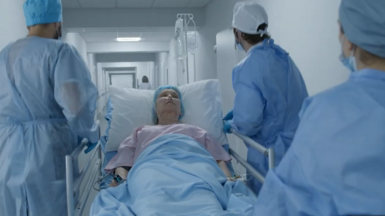New WHO recommendations on seasonal influenza immunization from the Strategic Advisory Group of Experts on Immunization (SAGE) - adding pregnant women as the highest priority and consideration of immunising children aged 6 months to 5 yearsArchived
WHO’s regular meeting of its Strategic Advisory Group of Experts (SAGE) on Immunization meeting (April 2012) included receiving a report from a Working Group on influenza immunisation.
WHO’s regular meeting of its Strategic Advisory Group of Experts (SAGE) on Immunization meeting (April 2012) included receiving a report from a Working Group on influenza immunisation. This led to a WHO statement on Influenza Immunization and a report from the whole meeting was published in the WHO Weekly Epidemiological Record of May 25th (1). The WER report includes a short statement on influenza vaccines replacing a 2005 statement.(2) The basis for these new SAGE recommendations is extensive work undertaken by the Working Group which led to a comprehensive background paper and a series of presentations.(3) This ECDC Public Health Development describes and explains the statement and report and comments on the implications for Europe (EU/EEA countries).
SAGE accepted the report of the Working Group and, as a new development highlighted pregnant women as the highest priority group for seasonal influenza vaccination. They were followed by recommendations for, in no particular priority order, children (6 months to 2 years and 2-5 years of age), older people, individuals of all ages (over 6 months) with underlying health conditions and health-care workers. The recommendations for immunising pregnant women and well children against seasonal influenza are new for WHO and for most European countries, though many countries and the EU Health Council recommended immunisation of pregnant women in the pandemic.(4)
Pregnant Women:
SAGE recommended that pregnant women should be vaccinated with conventional inactivated influenza vaccines noting that where countries are considering initiating or expanding influenza vaccination programs pregnant women should be the highest priority group. This recommendation was based on evidence of a substantial increased risk of severe disease in pregnant women (especially see in the pandemic with A(H1N1)pdm09), that the vaccine is effective and safe and particularly evidence from trials and observational studies of immunisation of mothers looking at the protection of their infants under 6 months of age against severe influenza disease.(5-7) Such young children have a high disease burden and cannot be vaccinated as the vaccines are not considered to work for them and are not licensed for this age group.(1,3)
Children 6 months to five years:
The recommendation for immunisation of children from 6 months but under 2 years was based on evidence of a high burden of severe disease. However the report noted that preventing influenza disease through immunisation in what is usually an influenza-naïve population is difficult.(3) Effective immunization usually requires two doses and is particularly dependent on the match between the vaccine and the circulating influenza viruses, even more so than in older individuals.(3) Children aged 2-5 years also have a high burden of disease, although less than their younger counterparts. An advantage for the 2-5 year group is that they respond better to vaccination with the injected trivalent activated vaccine (TIV). There also are new live attenuated influenza vaccines (LAIVs) which are taken nasally and provides broader and higher levels of protection. They are not licensed for children under 2 years of age following some increased risk of hospitalisation in younger children in trials of LAIVs.(3)
The other recommendations for health-care workers, older people and individuals with underlying health conditions are already well established though the background document considerably updates and improves the evidence base. (3,8,9)
The recommendations includes a number of important caveats reflecting that WHO statements have to fit very diverse settings. SAGE stated that the recommendation for children under 2 years should be considered as an additional target group only when sufficient resources are available for influenza prevention and with due consideration for competing health priorities and operational feasibility. Conversely a positive factor noted by SAGE was operational feasibility through pre-existing maternal and child health programmes. Finally SAGE recommended that the prioritization of specific target groups, local implementation timelines and target coverage goals should be determined at regional and country levels. This highlighted the importance of country-specific epidemiology, capacity and resources.(1,3)
ECDC Comment (25 May 2012):
It is welcome that this statement and recommendations are underpinned by a substantial background paper concerning influenza disease burden, vaccine performance, and safety in populations of all ages and the priority groups.(3) That did not exist for the 2005 guidelines.(2) These recommendations are also timely as they should be seen in the context of a major initiative to increase global influenza vaccine use and production especially in moderate and lower resource setting, the WHO-GAP programme.(10)
A recurrent difficulty for WHO is producing global recommendations that are specific enough to be useful but flexible enough to work in most settings. This truism does not apply so much for influenza immunisation. Some differences between countries are more tolerable from a public health perspective (though they can be operationally confusing and incomprehensible to professionals and the public) since the influenza vaccination strategy generally remains that of protecting vulnerable individuals, rather than reducing influenza circulation or eliminating human influenza infections. This contrasts with the high herd immunity strategies for polio, measles and rubella, which are also covered in the SAGE publication.(1) For the latter sub-optimal coverage in one country will sooner or later impact badly on others.(1) Also in a sense the previous WHO targets (75% per cent coverage)(2) did not have the epidemiological basis of the targets for polio, measles and rubella where countries are aiming at high herd immunity. WHO has quietly dropped the influenza targets in the 2012 recommendations.(1,2) As these targets were adopted also in the EU documentation there will need to be consideration as to whether to continue with them in Europe. (11) For these reasons there are provisos in the recommendations around regions or countries being able to decide themselves on which risk groups to prioritize for vaccination based on country-specific epidemiology, burden of disease, cost-effectiveness, feasibility, capacity and resources.(1) WHO specifically recommends that the prioritization of target groups, local implementation timelines and target coverage goals should be determined at regional and country levels. Finally SAGE noted that strengthening seasonal influenza immunisation programmes would assist in programmatic preparedness for pandemic vaccine introduction.(1)In the 2009 Council Recommendation the EU/EEA countries anticipated the WHO approach by committing to a regional influenza immunisation policy.(11,12) Though countries remain a long way from enacting this policy and gross inequalities exist between European countries in availability and acceptance of influenza vaccination in Europe, far more than for any of the standard childhood vaccinations.(4,13) However the WHO recommendations give difficulties for Europe is because the evidence-base for immunisation of the two new groups (pregnant women and young children) remains weak in Europe. Policy decisions rely heavily on studies from abroad, especially North America. Those studies, for example on vaccine effectiveness and safety in the USA are reassuring. It is not that there are data and analyses in Europe that would undermine this policy. Rather it cannot easily be said that there are yet strong data which support the new policy in the EU, especially that of making immunisation of pregnant women so preeminent. Also when dealing with the youngest children and pregnant women it is inevitable that there will be nervousness in Europe over safety and effectiveness among pregnant women, parents, those caring for children and pregnant women and those doing the immunising.(1,3,14,15) What data there are for Europe are also dominated by publications from the 2009 A(H1N1) pandemic, while these guidelines are for the rather different seasonal influenzas.(1,8) ECDC is currently coming towards the end of a process of reviewing that evidence in order to update its earlier guidance as required in the council recommendation.(8,9,11) The results will be published shortly but they will indicate continuing major European research gaps when it comes to seasonal influenza for example in the burden of maternal disease and safety and effectiveness of vaccines in mothers and children. It will remain the case for a while that policy decisions in Europe have to depend on data and analyses from other continents. Hence the need for continuing investment in public health related research, evaluation and surveillance of seasonal influenza disease and vaccination in Europe.
Comments and questions are welcomed and should be addressed to: influenza@ecdc.europa.eu.






